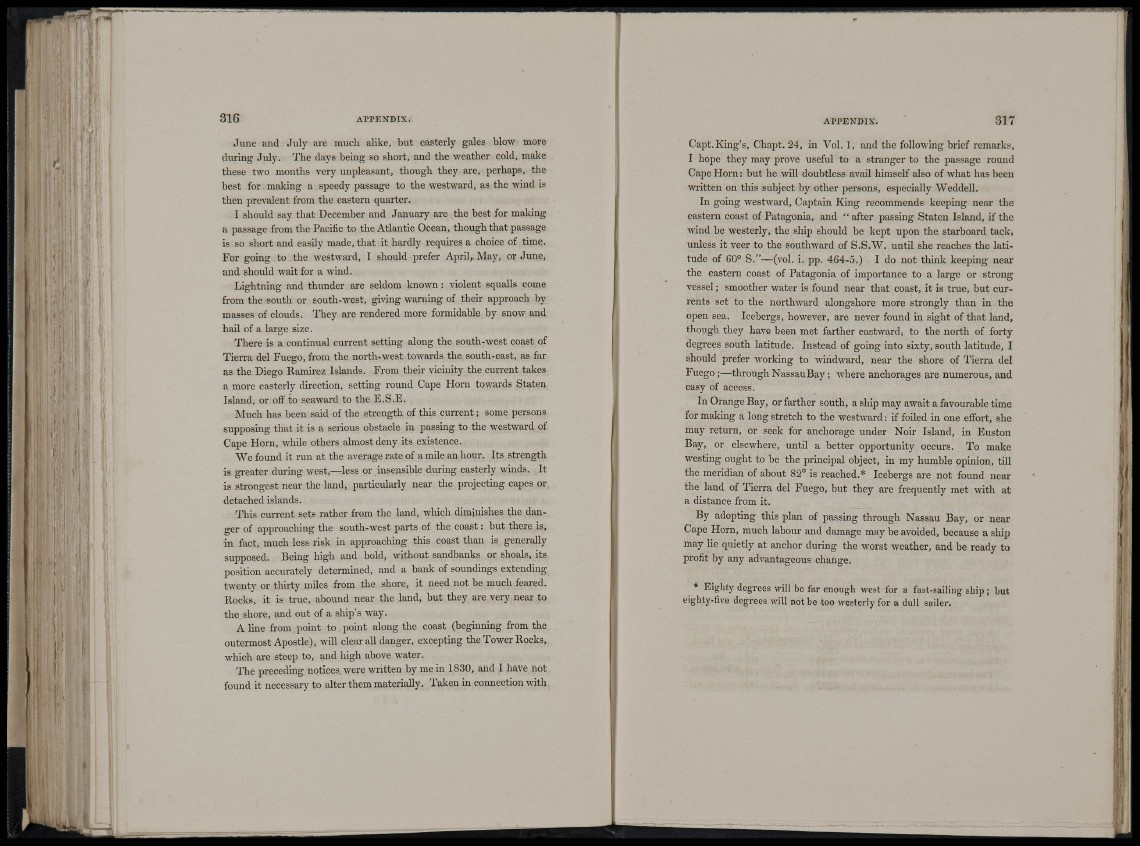
i i
; 1
, 1 ¡i' Î
•I II
1 ' k (à
ilil.
316 APPENDIX.
June and July are much alike, but easterly gales blow more
during July. The days being so short, and the weather cold, make
these two months very unpleasant, though they are, perhaps, the
best for making a speedy passage to the westward, as the wind is
then prevalent irom the eastern quarter.
I should say that December and January are the best for making
a passage from the Pacific to the Atlantic Ocean, though that passage
is so short and easily made, that it hardly requires a choice of time.
For going to the westwai'd, I should prefer April, May, or June,
and should wait for a wind.
Lightning and thunder are seldom known : violent squalls come
from the south or south-west, giving warnmg of their approach by
masses of clouds. They are rendered more formidable by snow and
hail of a large size.
There is a continual cm-rent setting along the south-west coast of
Tierra del Fuego, from the north-west towards the south-east, as far
as the Diego Ramirez Islands. From their vicinity the current takes
a more easterly direction, setting round Cape Horn towards Staten
Island, or off to seawai'd to the E.S.E.
Much has been said of the strength of this current ; some persons
supposing that it is a serious obstacle in passing to the westward of
Cape Horn, while others almost deny its existence.
We found it run at the average rate of a mile an hour. Its strength
is greater during west,—^less or insensible during easterly winds. It
is strongest near the land, particularly near the projecting capes or
detached islands.
Tliis current sets rather from the land, which diminishes the danger
of approaching the south-west parts of the coast : but there is,
in fact,, much less risk in approaching this coast than is generally
supposed. Being high and bold, without sandbanks or shoals, its
position accurately determined, and a bank of soundings extending
twentj' or thirty miles from the shore, it need not be much feared.
Rocks, it is true, abound near the land, but they are very near to
the shore, and out of a sliip's way.
A line from point to point along the coast (beginning from the
outermost Apostle), will clear aU danger, excepting the Tower Rocks,
which are steep to, and high above water.
The preceding notices, were written by me in 1830, and I have not
found it necessary to alter them materially. Taken in connection with
APPENDIX. S l l
Capt. King's, Chapt. 24, in Vol. 1, and the following brief remarks,
I hope they may prove useful to a stranger to the pas.sage round
Cape Horn: but he will doubtless avail himself also of what has been
TOtten on this subject by other persons, especially Weddell.
In going westward. Captain King recommends keeping near the
eastern coast of Patagonia, and " after passing Staten Island, if the
wind be westerly, the ship should be kept upon the starboard tack,
unless it veer to the southward of S.S.W. until she reaches the latitude
of 60° S."—(vol. i. pp. 464-5.) I do not think keeping near
the eastern coast of Patagonia of importance to a large or strong
vessel; smoother water is found near that coast, it is true, but currents
set to the northward alongshore more strongly than in the
open sea. Icebergs, however, are never found in sight of that land,
though they have been met farther eastward, to the north of forty
degrees south latitude. Instead of going into sixty, south latitude, I
should prefer working to windward, near the shore of Tierra del
Fuego;—through NassauBay; where anchorages are numerous, and
easy of access.
In Orange Bay, or farther south, a ship may await a favourable time
for making a long stretch to the westward: if foiled in one effort, she
may return, or seek for anchorage under Noir Island, in Euston
Bay, or elsewhere, until a better opportunity occurs. To make
westing ought to be the principal object, in my humble opinion, till
the meridian of about 82° is reached.* Icebergs ai-e not foimd near
the land of Tierra del Fuego, but they are frequently met with at
a distance from it.
By adopting this plan of passing through Nassau Bay, or near
Cape Horn, much labour and damage may be avoided, because a ship
may lie quietly at anchor during the worst weather, and be ready to
profit by any advantageous change.
• Eighty degrees will bo far enough west for a fast-sailing ship; but
eighty-live degrees will not be too westerly for a dull sailer.